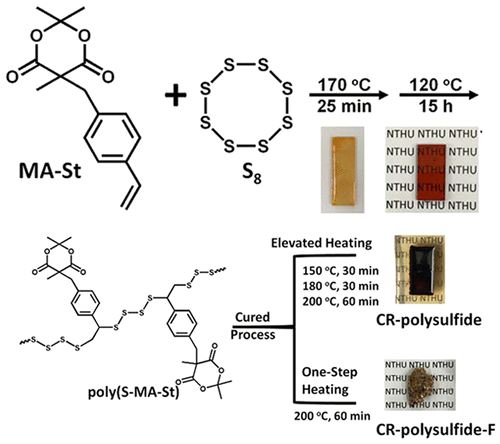当前位置:
X-MOL 学术
›
ACS Sustain. Chem. Eng.
›
论文详情
Our official English website, www.x-mol.net, welcomes your
feedback! (Note: you will need to create a separate account there.)
Cross-Linkable and Self-Foaming Polysulfide Materials for Repairable and Mercury Capture Applications
ACS Sustainable Chemistry & Engineering ( IF 7.1 ) Pub Date : 2019-01-24 00:00:00 , DOI: 10.1021/acssuschemeng.8b06815 Ho-Keng Lin,Yue-Sheng Lai,Ying-Ling Liu
ACS Sustainable Chemistry & Engineering ( IF 7.1 ) Pub Date : 2019-01-24 00:00:00 , DOI: 10.1021/acssuschemeng.8b06815 Ho-Keng Lin,Yue-Sheng Lai,Ying-Ling Liu

|
Inverse vulcanization involves reactions between elemental sulfur and unsaturated organic compounds to result in polysulfide materials. In this work, a Meldrum’s acid-containing styrene compound (MA-St) has been employed in the inverse vulcanization process for introduction of MA moieties to the corresponding polysulfide material (poly(S-MA-St)). Poly(S-MA-St) possesses self-cross-linking ability based on the sequential MA thermolysis and ketene (generated with MA thermolysis) dimerization reactions. With employing CO2, evolved with MA thermolysis reaction, as a foaming agent, poly(S-MA-St) also exhibits self-foaming feature in the thermally cross-linking process. Moreover, cross-linked poly(S-MA-St) material shows repairable property based on the dynamic polysulfide chains. As a result, poly(S-MA-St) is an effective agent for imparting repairable property to other polymers. On the other hand, cross-linked and foamed poly(S-MA-St), which possesses polysulfide chains and rich oxygen atoms and porous structure, has demonstrated a mercury absorption capacity of 52.0 ± 1.8 mg Hg/g sample. While a 100 mg sample being applied to 10 mL HgCl2 aqueous solution of a concentration of 2240 ppb in 3 h, a high mercury removal efficiency of 96% has been recorded. This work has demonstrated a new class of functional polysulfide materials on the viewpoints of both synthetic chemistry and application targets.
中文翻译:

用于可修复和汞捕集应用的可交联和自发泡的多硫化物材料
逆硫化涉及元素硫与不饱和有机化合物之间的反应,从而产生多硫化物材料。在这项工作中,在逆硫化过程中采用了迈德鲁姆(Meldrum)的含酸苯乙烯化合物(MA-St),用于将MA部分引入相应的多硫化物材料(poly(S-MA-St))。聚(S-MA-St)具有基于连续MA热解和乙烯酮(由MA热解生成)二聚反应的自交联能力。使用CO 2MA发生热分解反应后,作为发泡剂,聚(S-MA-St)在热交联过程中也表现出自发泡特性。此外,基于动态多硫化物链,交联的聚(S-MA-St)材料显示出可修复的性能。结果,聚(S-MA-St)是赋予其他聚合物可修复性的有效试剂。另一方面,具有多硫化物链和丰富的氧原子和多孔结构的交联泡沫聚(S-MA-St)的汞吸收容量为52.0±1.8 mg Hg / g。同时将100 mg样品应用于10 mL HgCl 2在3小时内浓度为2240 ppb的水溶液中,记录到的除汞效率高达96%。这项工作从合成化学和应用目标的角度展示了一种新型的功能性多硫化物材料。
更新日期:2019-01-24
中文翻译:

用于可修复和汞捕集应用的可交联和自发泡的多硫化物材料
逆硫化涉及元素硫与不饱和有机化合物之间的反应,从而产生多硫化物材料。在这项工作中,在逆硫化过程中采用了迈德鲁姆(Meldrum)的含酸苯乙烯化合物(MA-St),用于将MA部分引入相应的多硫化物材料(poly(S-MA-St))。聚(S-MA-St)具有基于连续MA热解和乙烯酮(由MA热解生成)二聚反应的自交联能力。使用CO 2MA发生热分解反应后,作为发泡剂,聚(S-MA-St)在热交联过程中也表现出自发泡特性。此外,基于动态多硫化物链,交联的聚(S-MA-St)材料显示出可修复的性能。结果,聚(S-MA-St)是赋予其他聚合物可修复性的有效试剂。另一方面,具有多硫化物链和丰富的氧原子和多孔结构的交联泡沫聚(S-MA-St)的汞吸收容量为52.0±1.8 mg Hg / g。同时将100 mg样品应用于10 mL HgCl 2在3小时内浓度为2240 ppb的水溶液中,记录到的除汞效率高达96%。这项工作从合成化学和应用目标的角度展示了一种新型的功能性多硫化物材料。





















































 京公网安备 11010802027423号
京公网安备 11010802027423号